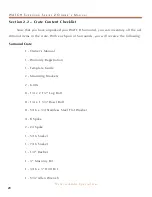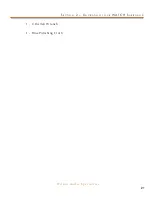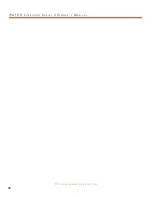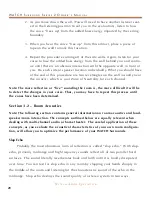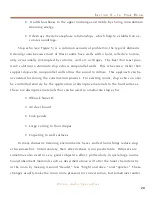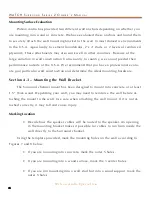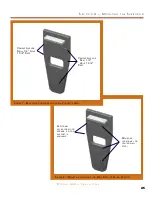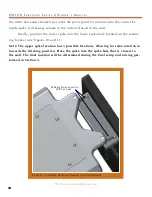
33
W i l s o n A u d i o S p e c i a l t i e s
S
e C T i o n
3 – i
n
y
o u r
r
o o M
• Structures within the listening room.
• The volume of air itself within the listening room.
Structural Resonance
Structural resonances are familiar to most people as buzzes and rattles, but this
type of resonance usually only occurs at extremely high volume levels and is usually
masked by the music. In many wood frame rooms the most common type of structural
resonance problem is “booming” of walls and floors. You can test for these very easily
by tapping the wall with the palm of your hand or stomping on the floor. Most rooms
exhibit mid-bass “boom” when struck. The loudspeaker playing in the room also ex-
cites these resonances. To give you an idea of what the perfect wall would sound like,
imagine rapping your hand against the side of a mountain. Structural wall resonances
generally occur in the low to mid-bass frequencies and add a false fullness to the ton-
al balance. They, too, are more prominent at louder levels, but their contribution to
the sound of the speaker is more progressive. Rattling windows, picture frames, lamp
shades, etc., can generally be silenced with small pieces of caulk or with blocks of felt.
However, short of actually adding additional layers of sheet rock to flimsy walls, there
is little that can be done to eliminate wall resonances.
Volume Resonance
The physical dimensions and volume of air in a room will also support standing
wave modes and resonances at frequencies determined by the size of that room. Larger
rooms will resonate at a lower frequency and have more complex (better) modal distri-
butions than will smaller rooms. Volume resonances, wall panel resonances, and low
frequency standing waves combine to form a low frequency coloration in the sound. At
its worst, it is a grossly exaggerated fullness, which tends to obscure detail and distort
the natural tonal balance of the speaker system.
Summary of Contents for Watch Surround 2 Series
Page 1: ...WAT C H S u r r o u n d S e r i e s 2 O w n e r s M a n u a l...
Page 7: ...7 Wi l s o n A u d i o S p e c i a l t i e s T a b l e o f C o n t e n ts...
Page 8: ...Wi l s o n A u d i o S p e c i a l t i e s...
Page 9: ...S e c t i o n 1 I n t r o d u c t i o n...
Page 16: ...Wi l s o n A u d i o S p e c i a l t i e s...
Page 17: ...S e c t i o n 2 U n c r a t i n g y o u r WAT C H S u r r o u n d...
Page 23: ...S e c t i o n 3 I n Yo u r R o o m...
Page 40: ...Wi l s o n A u d i o S p e c i a l t i e s...
Page 41: ...S e c t i o n 4 M o u n t i n g t h e WAT C H S u r r o u n d...
Page 52: ...Wi l s o n A u d i o S p e c i a l t i e s...
Page 53: ...S e c t i o n 5 F i n a l S y s t e m T u n i n g a n d Vo i c i n g...
Page 62: ...Wi l s o n A u d i o S p e c i a l t i e s...
Page 63: ...S e c t i o n 6 C a r e o f t h e F i n i s h...
Page 69: ...S e c t i o n 7 T r o u b l e s h o o t i n g...
Page 74: ...Wi l s o n A u d i o S p e c i a l t i e s...
Page 75: ...S e c t i o n 8 R e pa i r s...
Page 79: ...79 Wi l s o n A u d i o S p e c i a l t i e s or break a screw S e ct i o n 8 R e p a i r s...
Page 80: ...Wi l s o n A u d i o S p e c i a l t i e s...
Page 81: ...11 3 8 28 89 cm 12 7 16 31 52 cm 25 5 8 65 14 cm S e c t i o n 9 S p e c i f i c a t i o n s...
Page 86: ...Wi l s o n A u d i o S p e c i a l t i e s...
Page 87: ...S e c t i o n 1 0 Wa r r a n t y I n f o r m a t i o n...


